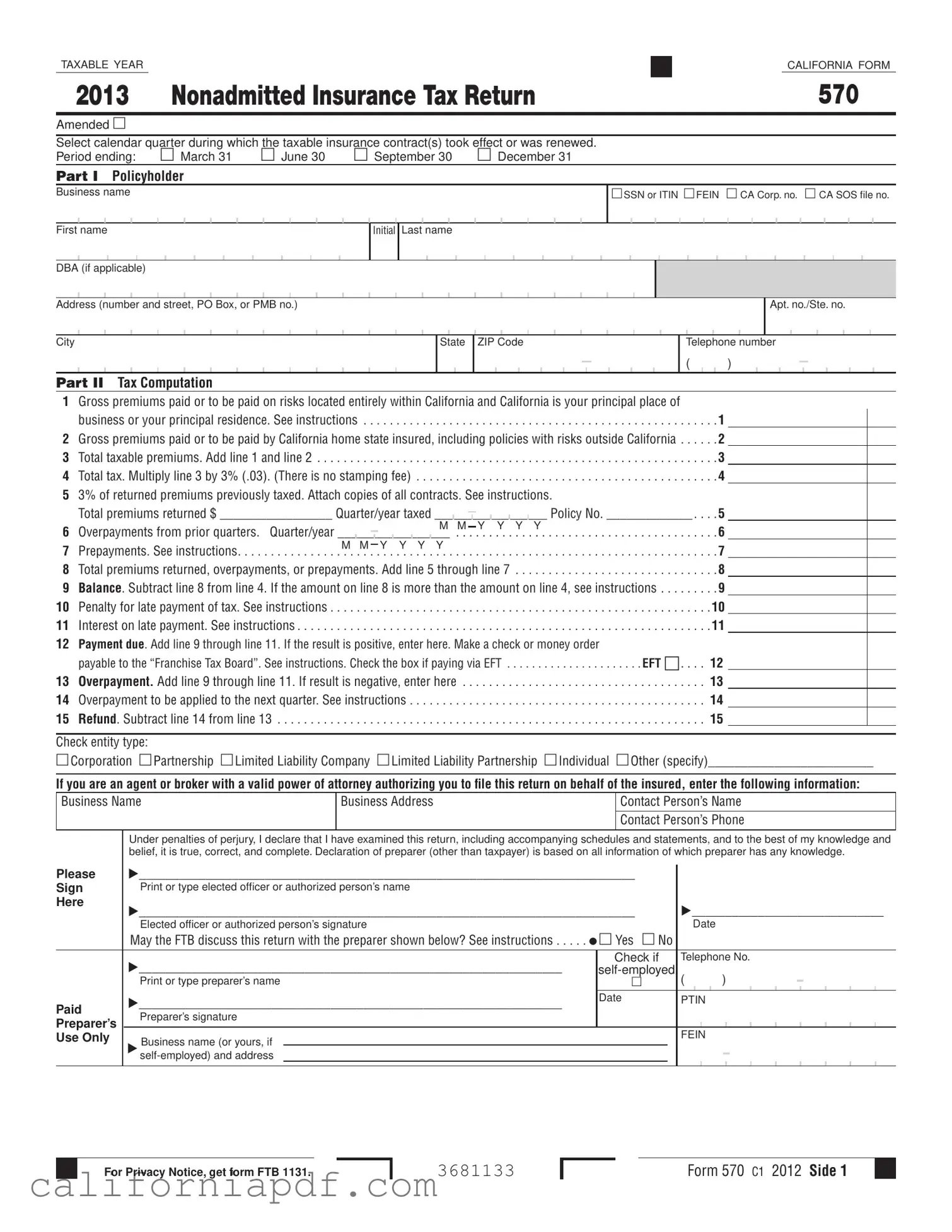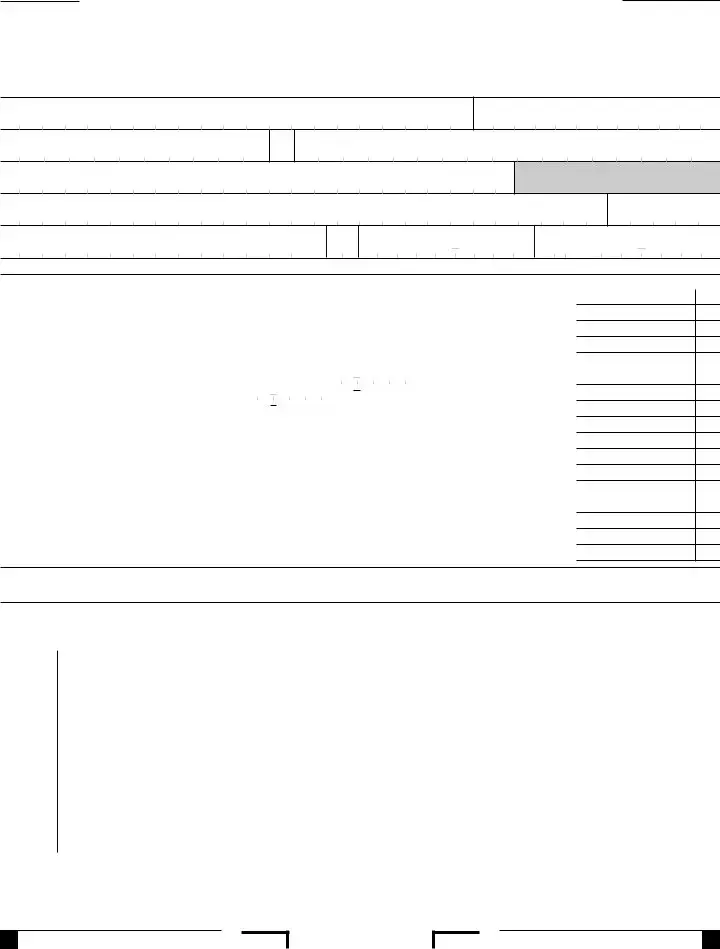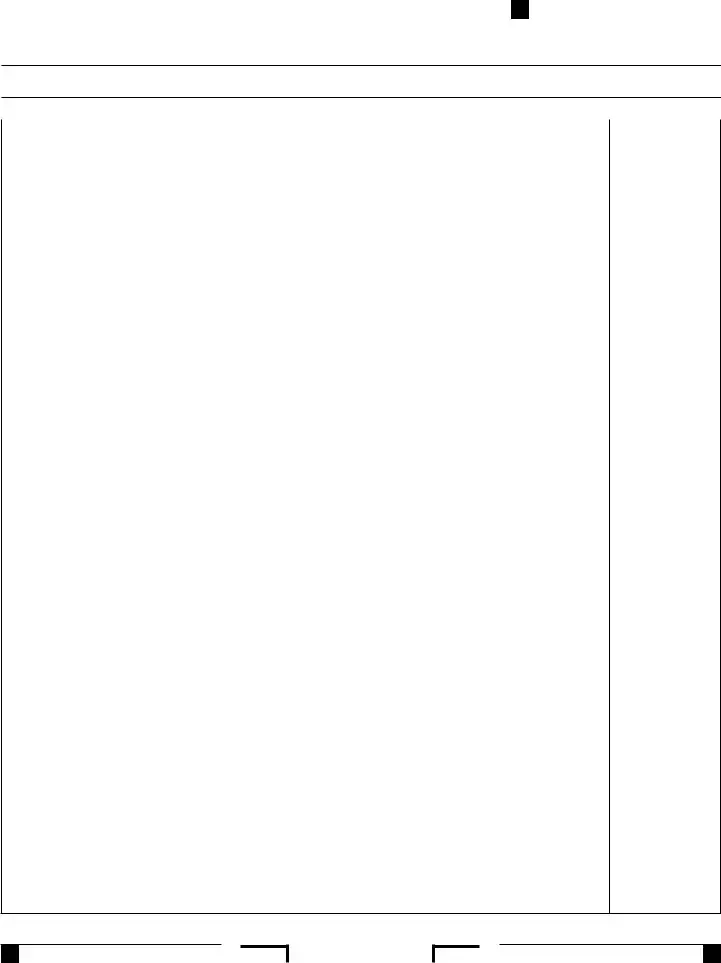•Give the FTB any information that is missing from the return.
•Call the FTB for information about the processing of the return or the status of any related refund or payments.
•Respond to certain FTB notices about math errors, offsets, and return preparation.
•The entity is not authorizing the paid preparer to receive any refund check, bind the entity to anything (including any additional tax liability), or otherwise represent the entity before the FTB.
The authorization will automatically end one year from the date this tax return was filed. If the entity wants to expand the paid preparer’s authorization, get form FTB 3520, Power of Attorney Declaration for the Franchise Tax Board. If the entity wants to revoke the authorization before it ends, notify the FTB in writing or call 800.852.5711.
Specific Instructions
Part I – Policyholder
Enter the business or individual policy holder name, Doing Business As (DBA), if applicable, address, and identification number. Print
all information using CAPITAL LETTERS. If completing Form 570 by hand, enter all the information requested using black or blue ink.
Part II – Tax Computation
Do not show net or negative amounts on line 1 through line 4 to account for returned premiums. See line 5 for returned premiums. Only use line 1 through line 4 to report taxable premiums paid or to be paid during the calendar quarter.
Line 1 – Enter all gross premiums paid or to be paid on risks located entirely within California for policies entered into or renewed during the calendar quarter.
Line 2 – Enter all gross premiums paid or to be paid by California home state insured for all policies issued by a nonadmitted insurer for coverage both inside and outside of California which were entered into or renewed during the calendar quarter. Note: Enter only premiums for policies related to risks within the U.S.
Line 5 – Enter three percent (.03) of the premiums returned during the calendar quarter because of cancellation or reduction of premiums on which nonadmitted insurance tax was paid.
Enter the quarter that the returned premiums were originally taxed. If the returned premiums are from more than one quarter or policy, attach a schedule showing the amount of returned premiums from each quarter and/or policy.
Returned premiums must be claimed on a return for the calendar quarter during which the returned premiums were received. Refunds resulting from returned premiums must be claimed within four years from the original due date of the return, four years from the date the return was filed or one year from the date of cancellation or reduction of premium, whichever is later.
If you are an agent or broker filing this return on behalf of the insured, the refund will be mailed to you in the name of the insured if a signed Power of Attorney is on file allowing the FTB to do so.
Attach copies of all contracts where there was a reduction of premiums returned or cancellation on which nonadmitted insurance tax was paid.
Line 6 – Enter the amount of overpayment you requested to be applied from a prior quarter that was not applied on a previously filed return. These payments may include amounts from an amended Form 570. Enter the calendar quarter and taxable year as MM-YYYY of the calendar quarter the overpayment occurred. For example, if the calendar quarter and tax year is September 30, 2010, enter 09-2010.
Line 7 – Enter any payments made before filing the return. If the return is being filed after the due date, see the instructions for line 10.
Line 9 – If the amount on line 4 is more than the amount on line 8, subtract line 8 from line 4 and enter the balance on line 9, you have tax due. If the amount on line 8 is more than the amount on line 4, subtract line 4 from line 8 and enter the result in brackets on line 9, your credits exceed your tax.
Line 10 – If you do not pay the tax due by the due date, a penalty of 10% of the amount of tax due will be imposed. Enter 10% of the amount of tax not paid by the due date. (A penalty of 25% of the amount of tax due will be imposed when nonpayment or late payment is due to fraud.)
Line 11 – Interest will be charged on any late payment and penalty from the due date to the date paid. Interest compounds daily and the interest rate is adjusted twice a year. If you do not include interest with your late payment or include only a portion of it, the FTB will compute the interest and bill you for it.
Line 12 – Enter the total amount due. Make your check or money order payable to the “Franchise Tax Board.” Write the calendar quarter (March, June, September, or December), the applicable taxable year, Form 570, and your social security number (SSN), individual taxpayer identification number (ITIN), California corporation number, federal employer identification number (FEIN), or California Secretary of State (SOS) file no. on the check or money order. Check the EFT box if you made your payment by EFT.
Electronic Funds Transfer (EFT) – To submit your nonadmitted insurance tax payment using EFT, use the following tax type code, EFT code 02020. You must use the correct EFT code to ensure proper credit to your FTB account.
Line 14 – Enter the amount of overpayment to be credited to your next quarter’s return.
Part III – Insurance Contracts
Column a – Enter the policy number for each contract. Enter only policies related to risks within the U.S.
Column b – Enter the name of all the Nonadmitted Insurance Companies for each contract.
Column c – Enter the type of insurance coverage provided by the contract.
Column d – Enter the full name or the two letter abbreviation of the state where the risk is located for each contract. If your policy covers more than one state, then use additional lines to list the locations of the risk separately.
Column e – Enter the total premium amount for each contract.
Total – Enter the total of Form 570, Side 2, column e.
Additional Information
If you have questions, contact: FTB Nonadmitted Insurance Desk at 916.845.7448 or call the Withholding Services and Compliance automated number at 888.792.4900.
OR write to:
WITHHOLDING SERVICES AND COMPLIANCE MS F182 FRANCHISE TAX BOARD
PO BOX 942867 SACRAMENTO CA 94267-0651
You can download, view, and print California tax forms and publications at ftb.ca.gov.
OR to get forms by mail write to:
TAX FORMS REQUEST UNIT MS F284 FRANCHISE TAX BOARD
PO BOX 307
RANCHO CORDOVA CA 95741-0307
For all other questions unrelated to withholding or to access the TTY/TDD numbers, see the information below.
Internet and Telephone Assistance
Website: |
ftb.ca.gov |
Telephone: 800.852.5711 from within the |
|
United States |
|
916.845.6500 from outside the |
|
United States |
TTY/TDD: |
800.822.6268 for persons with |
|
hearing or speech impairments |
Asistencia Por Internet y Teléfono |
Sitio web: |
ftb.ca.gov |
Teléfono: |
800.852.5711 dentro de los Estados |
|
Unidos |
|
916.845.6500 fuera de los Estados |
|
Unidos |
TTY/TDD: |
800.822.6268 personas con |
|
discapacidades auditivas y del habla |





